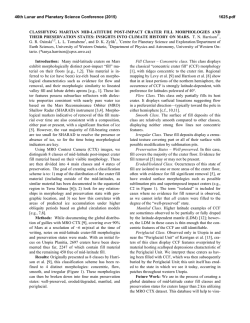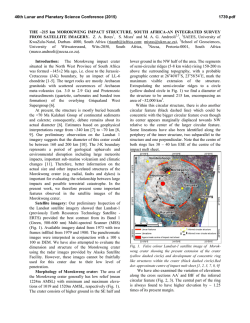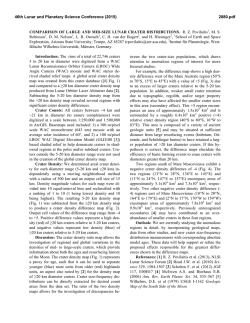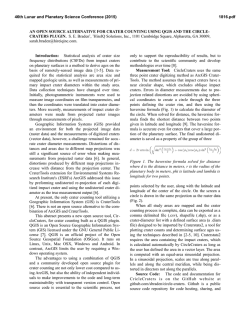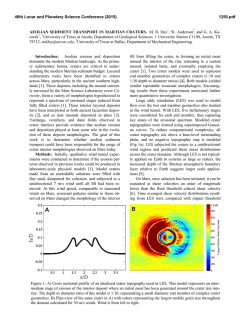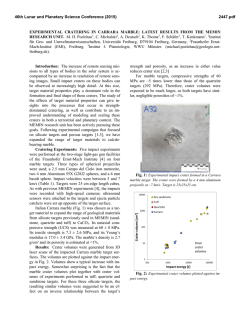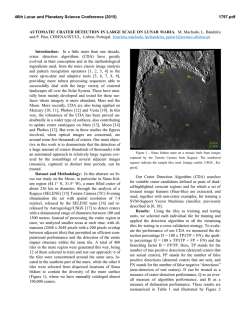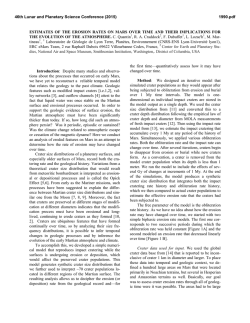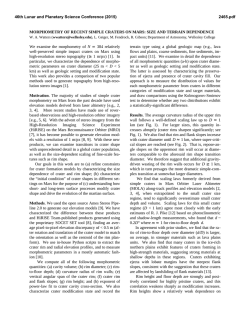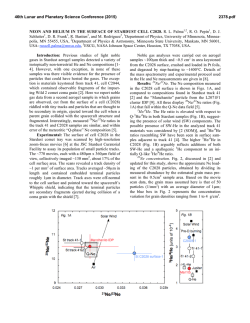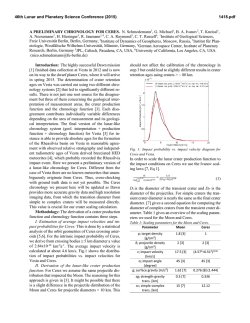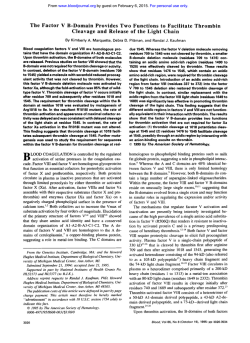
Further Oxygen Isotope Measurements for Two Cometary Impact
46th Lunar and Planetary Science Conference (2015) 2621.pdf FURTHER OXYGEN ISOTOPE MEASUREMENTS FOR TWO COMETARY IMPACT CRATER 1 1 1 RESIDUES: STILL LIKE CHONDRITES. C. J. Snead , K. D. McKeegan , P. Boehnke and A.T. Kearsley2,3 1 Dept. of Planetary, and Space Sciences, UCLA, Los Angeles, CA, 90095-1567, USA. [email protected]. 2 Dept. of Mineralogy, Natural History Museum, London SW7 5BD, UK. 3School of Physical Sciences, University of Kent, Cantebury CT2 7NH, UK. Introduction: The NASA Stardust mission sucThe aluminum foil substrates on the Stardust colcessfully returned samples from comet 81P/Wild 2 and lector provided an auxiliary, low oxygen background provided, for the first time, an opportunity to measure alternative to the aerogel for measuring both coarse and the bulk oxygen isotope composition comet dust. Prefine-grained components of impacting Wild 2 dust parcision measurements of material from a Kuiper belt ticles. Numerous laboratory hypervelocity impact exobject have the potential to contrain models for the periments demonstrate that at the encounter velocity of origin and evolution of oxygen isotope heterogeneities Stardust with Wild 2 craters in aluminum foils likely retain much of the impacting cometary material in a in the early solar nebula. 17O and 18O values of calwell defined location (the crater), regardless of impaccium-aluminum rich inclusions define a mixing line of tor grain size. In addition, large, single mineral impacslope ~1 between a 16O rich reservoir and a relatively 16 tors can be distinguished from fine-grained cluster imO poor reservoir [1]. Results from the Genesis mispactors by examination of crater morphology. We sion place the Sun near the 16O-rich end of the CAI used the light gas gun at the University of Kent in Canmixing line [2]; therefore, some mass-independent terbury to fire particles of known isotopic composition process enriched planetary materials in proportionally into aluminum foil targets to assess potential fractionequal amounts of 17O and 18O. UV photodissociation tion effects resulting from hypervelocity capture. has been suggested as the mechanism for producing These effects have been found to be consistent at Starsuch a 17O and 18O enriched reservoir [3]. One predicdust encounter velocities, and can be used to normalize tion of a UV self-shielding model is that primordial ice measurements of Stardust impact crater residues. should have a composition of ~200-300‰ whereas We previously reported results of oxygen isotope dust should have a 16O-rich composition close to solar measurements of two Stardust impact crater residues (~-60‰). Thus far, oxygen isotope measurements of [7]; those values were found to plot on the terrestrial grains recovered from aerogel tracks have yet to confraction line. Here we report results for two addition firm this prediction; instead, measurements have reStardust craters, C2104W,4 and C2031W,3. vealed surprising similarites to minerals in carbonaTechniques and Results: Energy dispersive X-ray mapceous chondrites which have been interpreted as eviping of craters C2104 and C2031 was performed with a dence for large scale radial migration of dust compoBruker XFlash quad detector at the Natural History Museum, nents from the inner solar nebula to the accretion reLondon. C2031 was determined to be a Mg-rich oligions of Jupiter-family comets [4]. If this interpretation vine/pyroxene mix, with traces of FeS. The C2104 crater is correct, what these studies have so far not achieved residue contained abundant Fe, Ni, and S with trace oxygen is a measurement of the average oxygen isotope comon the crater floor; the oxygen did not appear to be strongly position of the dust component of material that formed correlated with other crater residues, leading to suspicion and accreted in the distal cold regions of the nebula that it represented contamination or oxidaton that occurred (well beyond the snow line). after capture. Synchrotron X-ray analyses of Stardust aerogel tracks suggest that in at least some tracks, 65-90% of the impactor mass resides in the upper portion of bulbous and carrot shaped aerogel tracks as submicron particles, while the larger (>1m) more robust terminal particles represent only 10-35% of the total mass of the impactor [5]. These analyses have led to a model (e.g. see Fig 11 of [6]) of impacting Wild 2 dust as aggregates of loosely bound fine-grained material containing the occasional larger olivine, pyroxene, iron sulfide and iron oxide grains. The fine grained component suffered intimate mixing with the oxygen-rich aerogel, Figure 1: Secondary electron images of C2031,W,3 making definitive oxygen isotope analysis of these ma(left) and C2104,W,4 (right), overlain by X-ray maps terials extremely challenging. for Mg (green in both), Si (blue in left), O (blue in right), S (red in left) and Fe (red in right). 46th Lunar and Planetary Science Conference (2015) The craters were then cut from the foil targets, flattened and pressed into indium-filled reservoirs in 1” polished aluminum ion probe mounts. Each ion probe mount also contained a polished mineral standard (Afrique magnetite for C2104, and San Carlos olivine for C2031) at its center, as well as seven corresponding synthetic impact craters of the mineral standards. Oxygen isotopes were measured using a Cameca IMS-1270 ion probe with a 20keV, 0.5nA cesium primay beam of ~25m diameter. The detection system was configured for 3-oxygen isotope multicollection, with 16O measured on a Faraday cup, and 17O and 18O measured on electron multipliers. Individual crater analyses consisted of 100 count cycles of 5 seconds per cycle. All sputtered ions were counted (i.e. we did not use a fixed presputter). After applying background, yield and deadtime corrections, we performed a change-point analysis on our data via R [8,9] in order to determine when the sample reached sputtering equilibrium; data points collected prior to the change point were excluded. Change-point analysis was also used to determine whether the residue had completely sputtered (which was observed for C2031). Figure 2: Measurements of craters C2122W,4, C2067N,3 and C2031,W,3 normalized to Afrique Magnetite and San Carlos olivine simulated crater impacts. Analysis of C2104 revealed an 16O count rate that fell below 5x106 counts per second within the first 50 cycles of analysis, which is more indicative of oxide layers of blank aluminum foil analyses rather than of crater residues [10]. These results, as well as the weak correlation between the oxygen and the residue in the 2621.pdf SEM analysis lead us to conclude that the residue was originally an Fe/Ni sulfide or metal that oxidized terrestrially. Three analyses of C2031W,3 yielded crater normalized 18O values of 1.00.6‰, 1.60.3‰ and 2.70.4‰ (1 s.e.) and crater normalized 17O values od 1.81.3‰, 3.80.8‰ and 5.61.0‰ (1 s.e.). These values fall within the range of bulk ordinary chondrite measurements, and are consistent with some measurements of particles extracted from aerogel tracks [11]. Thus far, none of the analyzed crater residues have 16O-rich compositions that are predicted for comet dust by UV self-shielding models, though the sample size is small. We plan to measure ten more Stardust crater residues in the future in order to report a bulk oxygen isotopic composition of comet 81P/Wild 2 dust. Acknowledgements: We thank NASA for access to the Stardust samples; Tomasz Goral and John Spratt of NHM (London) for help in X-ray mapping. References: [1] Clayton R. N. et al. (1973) Science, 182, 485-488. [2] McKeegan K. D. et al. (2011) Science, 332, 1528-1532. [3] Clayton, R.N. (2002) Nature, 415, 860-861. [4] McKeegan, K.D. et al. (2006) Science, 314, 1724-1728. [5] Flynn G. J. et al. (2006) Science, 314, 1731-1735. [6] Kearsley A.T. et al. (2009) Meteoritics & Planet. Sci, 44 1489-1510. [7] Snead C. J. (2014) LPS XLV, Abstract #2928. [8] R CoreW Team (2013) R Foundation for Stati stical Computing, Vienna, Austria. [9] Killick, R. and Eckley, I (2013) R package. [10] Snead, C.J. et al. 77th Meteoritical Society, Abstract #5330. [11] Nakamura T. et al. (2008) Science, 321, 1664-1667.
© Copyright 2025

